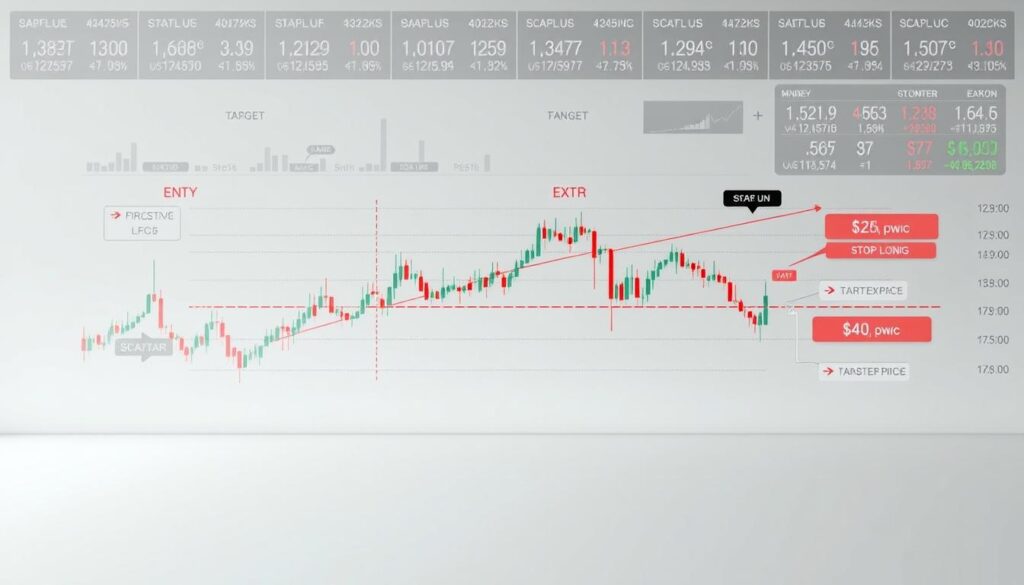Scalping Strategies: Profiting from Small Price Moves

Are you searching for a trading technique to make money from small price changes? Scalping is a fast-paced trading method that aims to catch many small, profitable price moves. With the right scalping strategies, you can make a lot of money.
This guide will teach you the basics of profitable scalping techniques and how to use them in your trading. You’ll learn how to spot opportunities, manage risks, and increase your earnings with effective trading techniques.
Key Takeaways
- Understand the basics of scalping and its relevance in modern trading.
- Learn how to identify small price movements for profit.
- Discover effective risk management techniques for scalping.
- Explore various profitable scalping techniques.
- Understand how to maximize returns using the right trading techniques.
Understanding the Scalping Trading Approach
To master scalping, you first need to understand its fundamental principles. Scalping is a trading strategy that focuses on making numerous small trades throughout the day. It takes advantage of minor price movements. This approach requires a deep understanding of market dynamics and the ability to make quick decisions.
Definition and Core Principles of Scalping
Scalping is defined as a trading strategy that involves executing a large number of trades in a short period. It’s usually done within a single trading day. The core principle of scalping is to capitalize on small price movements, often just a few pips or cents per trade.
Scalpers rely on high liquidity and high trading volumes to facilitate their trades. They use technical analysis and real-time data to make informed decisions quickly.

How Scalping Differs from Day Trading and Swing Trading
While scalping is a form of day trading, not all day trading is scalping. Day trading involves making multiple trades within a day. The holding period can vary from minutes to hours. Scalping, on the other hand, focuses on very short-term trades, often holding positions for mere seconds or minutes.
Swing trading involves holding positions for several days or even weeks. It’s a longer-term strategy compared to scalping and day trading. Understanding these differences is key for traders to choose the strategy that best fits their goals and risk tolerance.
Developing the Scalper’s Mindset
To succeed in scalping, you need a specific mindset. This mindset helps you make quick decisions under pressure. It involves having traits that keep you focused and calm during stressful trading times.
Essential Psychological Traits for Success
Successful scalpers have key traits like discipline, focus, and quick decision-making. They also need to manage their emotions well to avoid acting impulsively. A trading expert once said,
“The ability to remain calm and objective is key in scalping’s fast world.”
This calmness helps scalpers stick to their strategies, even when the market is volatile.
Overcoming Emotional Trading Challenges
To beat emotional trading challenges, scalpers must manage stress and keep their minds clear. They can use meditation, set clear goals, and rely on scalping indicators for decisions. By sticking to their plan, scalpers can reduce how much emotions affect their trading.

Identifying Optimal Market Conditions for Scalping
Scalping success depends on knowing the best market times. You must spot the factors that make a market good for scalping. This means looking at different market parts to find the right scalping moments.
Volatility Requirements and Measurement
Scalping works best in markets with big price swings. You can check volatility with tools like the Average True Range (ATR). High volatility means more chances for scalpers.
Liquidity Factors and Volume Analysis
Liquidity is key for scalping, letting you trade fast without price changes. Look at trading volume to see if a market is liquid. A liquid market has small bid-ask spreads, cutting costs.
| Liquidity Factor | Importance for Scalping | Indicator |
|---|---|---|
| Trading Volume | High volume ensures liquidity | Volume bars or histograms |
| Bid-Ask Spread | Tight spreads reduce costs | Bid-ask spread indicators |
| Market Depth | Deep markets can absorb large trades | Depth of market (DOM) tools |
Prime Trading Sessions and Market Hours
When you trade matters a lot. Some times are better than others. Look for the London-New York overlap for high liquidity and volatility.
“The key to successful scalping is not just understanding market conditions but also timing your trades to coincide with the most active and liquid market periods.”
Knowing the best market times can boost your scalping game. This can lead to more consistent profits.
Proven Scalping Strategies for Consistent Profits
Using the right scalping strategies can really boost your trading success. Scalping needs traders to quickly adjust to market changes.
Range-Based Scalping Techniques
Range-based scalping finds currency pairs or assets in a clear range. Traders buy at the low end and sell at the high end, making money from the swings. It’s all about knowing support and resistance levels well.
Momentum and Trend-Following Methods
Momentum scalping looks for assets moving strongly in one direction. Traders follow this movement to catch a part of it before it turns. This method uses technical indicators to spot strong trends.
Breakout and Reversal Scalping Approaches
Breakout scalping starts when an asset breaks out of its range or resistance. Reversal scalping finds overbought or oversold spots for a reversal. Both need fast action and a good grasp of market moves.
| Scalping Strategy | Description | Key Indicators |
|---|---|---|
| Range-Based | Buying at support, selling at resistance | Support and Resistance Levels, RSI |
| Momentum | Riding the trend | Momentum Indicators, Moving Averages |
| Breakout/Reversal | Trading on breakouts or reversals | Bollinger Bands, Stochastic Oscillator |
Learning these scalping strategies can help traders make money more often. Each method has its own benefits and challenges. Success comes from adjusting these techniques to fit different market situations.
Advanced Scalping Techniques for Experienced Traders
To improve your scalping, add advanced techniques to your trading tools. As an experienced trader, you know the basics. But, using more complex methods can really boost your results.
Order Flow Analysis and Market Depth Reading
Order flow analysis looks at buy and sell orders to understand market feelings and price changes. By studying market depth, you find support and resistance points. This helps you make better trading choices. It’s great for high-frequency trading because quick action is key.
Cross-Market Arbitrage Opportunities
Cross-market arbitrage finds price differences between markets or instruments. By spotting these, you can make money from short-term price gaps. It needs a good grasp of market movements and fast action.
High-Impact News Event Trading
Trading on big news events can be very profitable. These events often lead to big price swings. Knowing about upcoming news lets you prepare and make the most of market reactions. This mix of scalping indicators and understanding market feelings is key.
Adding these advanced methods to your scalping can make you better and keep you ahead in fast-paced intraday trading.
Essential Technical Indicators for Scalping Success
For scalpers, the right technical indicators are key to making money. These tools help spot trading chances, manage risks, and make quick decisions.
Fast-Moving Averages and MACD Configuration
Fast-moving averages, like the 5-period or 8-period EMA, are vital for spotting short-term trends. Pairing them with the MACD (Moving Average Convergence Divergence) indicator helps find entry and exit points. Adjust the MACD settings to see divergence clearly.
Example: Use a 5-period EMA and MACD with a histogram to spot divergence in a trending market.
Momentum Oscillators: Stochastic and RSI Settings
Momentum oscillators, such as Stochastic and RSI (Relative Strength Index), show overbought and oversold levels. For scalping, tweak the Stochastic Oscillator to a shorter period (e.g., 5, 3, 3) to catch quick reversals. Use a 6-period or 8-period RSI to detect momentum shifts early.
Volatility Tools: Bollinger Bands and ATR
Volatility tools are key to understanding market conditions. Bollinger Bands show volatility and breakout points. The Average True Range (ATR) indicator measures price movement range. Use Bollinger Bands with a 20-period SMA and ATR with a 14-period setting for effective scalping.
| Indicator | Setting | Purpose |
|---|---|---|
| Fast-Moving Average | 5-period EMA | Identify short-term trends |
| MACD | 12, 26, 9 | Spot entry and exit points |
| Stochastic Oscillator | 5, 3, 3 | Detect overbought/oversold conditions |
| RSI | 6-period or 8-period | Gauge momentum shifts |
| Bollinger Bands | 20-period SMA | Visualize volatility |
| ATR | 14-period | Measure average price range |
By mixing these technical indicators and tweaking their settings, you can craft a strong scalping strategy. It will work well in different market conditions.
Optimizing Your Trading Setup for Rapid Execution
Getting your trading setup right is key to fast and efficient trades. A top-notch trading environment lets you make the most of small price changes. This is super important for scalping.
Hardware and Internet Requirements
You need a strong computer with lots of cores, plenty of RAM, and a great graphics card. Also, make sure your internet is fast and always on. Having a backup internet is smart, just in case.
Using a wired connection is better than Wi-Fi to cut down on delays. A top computer and solid internet are the core of a good scalping setup.
Chart Configurations and Multiple Timeframe Analysis
Set up your charts to look at different timeframes. This gives you a full picture of the market. Use both short and long timeframes to spot trends and when to enter the market.
One-Click Trading and Hotkey Optimization
Use one-click trading and hotkeys to make your trading smoother. This way, you can trade fast, cutting down the time between deciding and doing.
| Feature | Benefit | Implementation |
|---|---|---|
| One-Click Trading | Rapid Execution | Enable in trading platform settings |
| Hotkey Optimization | Efficient Trading | Assign frequently used actions to hotkeys |
By improving these parts of your trading setup, you’ll trade faster and grab more market chances.
Risk Management Principles for Scalping Traders
To succeed in scalping, mastering risk management is key. Scalping means making many trades quickly. This makes managing risk even more important to protect your money and grow your profits over time.
Calculating Position Size and Using Proper Leverage
Finding the right position size is critical in scalping. You need to figure out the best lot size based on your account balance and how much risk you can take. Using the right leverage is also important. It can increase your gains but also your losses. Choose a leverage that lets you manage a big position size without risking too much. Starting with a leverage of 10:1 is often a good choice for many scalpers.
Setting Precise Stop Losses and Take Profit Levels
Setting clear stop losses and take profit levels is key to managing risk. Stop losses limit your losses if the market goes against you. Take profits lock in your gains when the market goes your way. Make sure your stop losses aren’t too tight to avoid early stop-outs. Also, don’t set your take profits too close to your entry to miss out on big gains.
Daily Loss Limits and Drawdown Management
Setting daily loss limits and managing drawdowns are vital for risk management. Set a daily loss limit that fits your trading plan and risk tolerance. This prevents big losses that could empty your trading account. Also, keep an eye on your drawdown—the biggest drop in your account balance. This shows how well your trading strategy is doing and if you need to make changes.
Following these risk management tips can improve your trading skills and success in scalping.
Best Markets for Implementing Scalping Strategies
To make money through scalping, finding the right markets is key. Each market has its own opportunities based on things like how much it moves, how easy it is to trade, and when you can trade.
Forex Pairs with Ideal Scalping Characteristics
The Forex market is great for scalping because it’s very liquid and moves a lot. Pairs like EUR/USD, GBP/USD, and USD/JPY are popular. They have small spreads and lots of trading.
| Currency Pair | Average Daily Volatility | Typical Spread |
|---|---|---|
| EUR/USD | 80-100 pips | 0.5-1 pip |
| GBP/USD | 100-120 pips | 1-2 pips |
| USD/JPY | 80-100 pips | 0.5-1 pip |
High-Liquidity Stocks and Index Futures
High-liquidity stocks and index futures are good for scalpers too. Big companies and well-known indexes like the S&P 500 or Dow Jones are good. They have lots of trading and move a lot.
For example, big companies like Apple or Microsoft have lots of trading. This makes it easy to quickly buy and sell.
Cryptocurrency Markets: Opportunities and Challenges
The cryptocurrency market is very volatile, which is good for scalpers. But, it’s also risky because it’s less liquid than other markets. Prices can change a lot.
Scalpers in crypto often focus on big coins like Bitcoin and Ethereum. These coins are more liquid.
Avoiding Critical Scalping Pitfalls and Mistakes
To succeed in scalping, it’s key to avoid common mistakes. Scalpers must watch out for overtrading, high transaction costs, and not adapting to market changes.
Overtrading and Trader Burnout Prevention
Overtrading can cause big losses. To avoid it, set clear trading limits and stick to them. Taking regular breaks and planning your trading schedule can also prevent burnout. This keeps you focused and alert during trading.
Managing Transaction Costs and Slippage
Transaction costs and slippage can eat into your profits. To reduce these, choose brokers with low fees and use limit orders. Also, be aware of market liquidity and avoid trading when it’s low to lessen slippage.
Adapting to Changing Market Conditions
Markets change fast, and what works today might not tomorrow. To stay on top, keep an eye on market conditions and tweak your strategies as needed. This could mean switching scalping techniques or stopping trading during uncertain times.
Conclusion: Creating Your Personalized Scalping Trading Plan
Now that you’ve looked at different scalping strategies, it’s time to make a plan that fits you. This plan should include the strategies, risk management, and market analysis from this guide.
To make your scalping trading plan, first pick the markets and instruments that match your goals. Think about how much risk you can take, how much time you have to trade, and which strategies you like. Then, set clear rules for when to enter and exit trades, how big your positions should be, and how to manage risks.
A good trading plan keeps you focused and stops you from making quick, bad decisions. Keep checking and updating your plan as the market changes and you get better at trading. With a plan made just for you, you’ll be ready to handle the markets and make steady profits.
Scalping well means being disciplined, patient, and always learning. Stick to your plan and keep improving it to get the best results.
FAQ
What is scalping in trading, and how does it differ from other strategies?
What are the key psychological traits required for successful scalping?
How do I identify optimal market conditions for scalping?
What are some proven scalping strategies for consistent profits?
How can I optimize my trading setup for rapid execution?
What are the best technical indicators for scalping success?
How do I manage risk when scalping?
Which markets are best suited for scalping?
What are some common pitfalls to avoid when scalping?
How can I develop a personalized scalping trading plan?
What is high-frequency trading, and how does it relate to scalping?
How do I stay disciplined and avoid emotional trading when scalping?
READ MORE : Best Brokers to Maximize Your Trading Success in 2025



